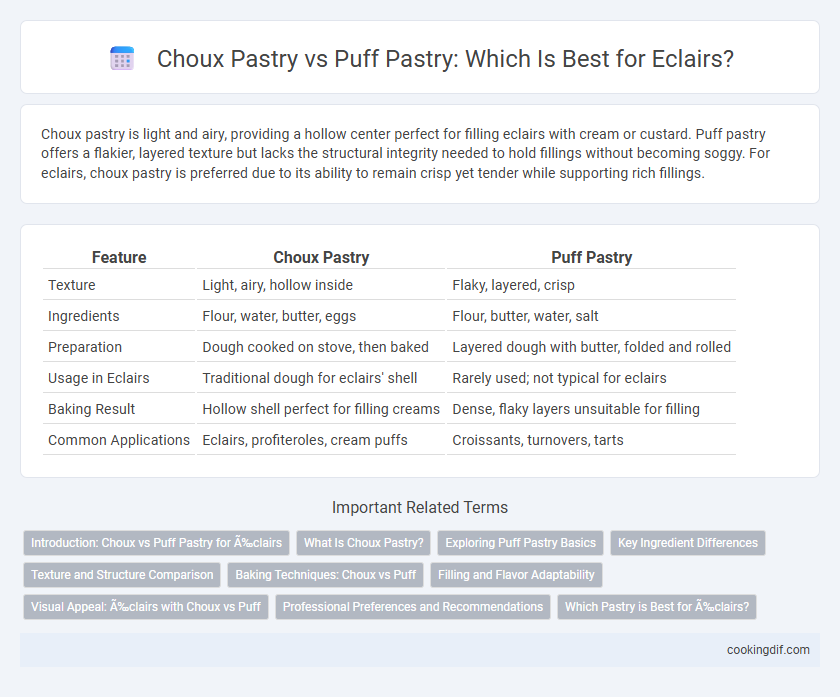Choux pastry is light and airy, providing a hollow center perfect for filling eclairs with cream or custard. Puff pastry offers a flakier, layered texture but lacks the structural integrity needed to hold fillings without becoming soggy. For eclairs, choux pastry is preferred due to its ability to remain crisp yet tender while supporting rich fillings.
Table of Comparison
| Feature | Choux Pastry | Puff Pastry |
|---|---|---|
| Texture | Light, airy, hollow inside | Flaky, layered, crisp |
| Ingredients | Flour, water, butter, eggs | Flour, butter, water, salt |
| Preparation | Dough cooked on stove, then baked | Layered dough with butter, folded and rolled |
| Usage in Eclairs | Traditional dough for eclairs' shell | Rarely used; not typical for eclairs |
| Baking Result | Hollow shell perfect for filling creams | Dense, flaky layers unsuitable for filling |
| Common Applications | Eclairs, profiteroles, cream puffs | Croissants, turnovers, tarts |
Introduction: Choux vs Puff Pastry for Éclairs
Choux pastry, a light and airy dough made from butter, water, flour, and eggs, is traditionally used for eclairs due to its ability to puff up and create a hollow center perfect for filling. Puff pastry, composed of multiple layers of butter and dough, offers a flaky, buttery texture but lacks the hollow interior essential for classic eclairs. Understanding the structural differences between choux and puff pastry is key to achieving the ideal eclair texture and presentation.
What Is Choux Pastry?
Choux pastry, or pate a choux, is a light, airy dough made from flour, butter, water, and eggs, designed to puff up and create hollow centers when baked. Unlike puff pastry, which relies on layers of butter folded into dough for flakiness, choux pastry uses steam produced during baking to achieve its rise. This unique structure makes choux ideal for eclairs, providing a crisp outer shell and a soft, hollow interior perfect for fillings.
Exploring Puff Pastry Basics
Puff pastry, characterized by its multiple layers of dough and butter, creates a light, flaky texture ideal for eclairs, contrasting with the denser, hollow structure of choux pastry. Mastering puff pastry techniques involves careful folding and rolling to develop the perfect rise and crispness in the final product. Understanding the foundational differences between puff and choux pastry enhances the selection process for creating eclairs with desired texture and flavor profiles.
Key Ingredient Differences
Choux pastry for eclairs relies on a high moisture dough made from water, butter, flour, and eggs, creating a light, airy interior when baked. Puff pastry, composed of numerous layers of butter folded into dough, results in a flaky, crisp texture unsuitable for the classic eclair shape. The distinct moisture and fat content in choux dough are crucial for its expansion and hollow center, differentiating it fundamentally from the laminated structure of puff pastry.
Texture and Structure Comparison
Choux pastry features a light, airy texture with a hollow structure ideal for holding cream fillings, achieved through high moisture content and steam leavening. Puff pastry offers a flaky, layered texture created by repeated folding and butter lamination, resulting in a crisp outer shell but denser interior unsuitable for cavity filling. The hollow interior of choux makes it preferable for eclairs, while puff pastry's layered crispiness suits tarts and turnovers better.
Baking Techniques: Choux vs Puff
Choux pastry relies on a high-moisture dough cooked on the stovetop before baking, creating steam that puffs the dough into a hollow, airy shell ideal for eclairs. Puff pastry, made from multiple layers of butter folded into dough, puffs by separating layers through steam but remains flakier and denser, less suited for holding cream fillings. Mastering choux dough's temperature control and piping technique is crucial for achieving eclairs with a crisp exterior and light, spacious interior perfect for pastry cream.
Filling and Flavor Adaptability
Choux pastry offers a delicate, airy texture that perfectly balances rich, creamy fillings such as pastry cream or whipped ganache, enhancing eclairs with a light mouthfeel and versatile flavor absorption. Puff pastry's multiple buttery layers provide a crisp exterior that complements denser, more indulgent fillings like chocolate mousse or custard, contributing to a richer overall taste experience. Both pastries adapt well to various flavors, but choux pastry excels in maintaining structural integrity while showcasing subtle, sweet fillings without overwhelming the palate.
Visual Appeal: Éclairs with Choux vs Puff
Eclairs made with choux pastry have a smooth, golden, and slightly airy exterior that creates a delicate, classic profile ideal for filling. Puff pastry eclairs display distinct, flaky layers with a crisp texture, offering a more rustic and visually textured appearance. The choice between choux and puff affects not only taste but also the eclairs' visual elegance and perceived lightness.
Professional Preferences and Recommendations
Professional pastry chefs often prefer choux pastry for eclairs due to its light, airy texture and ability to hold fillings without becoming soggy. Puff pastry, while flakier and richer, lacks the structural integrity required for traditional eclairs and is more commonly reserved for desserts like mille-feuille. Experts recommend choux pastry as the optimal choice for eclairs, ensuring the perfect balance of crispness and softness essential for professional-quality results.
Which Pastry is Best for Éclairs?
Choux pastry is the best choice for eclairs due to its light, airy texture and hollow interior, perfect for holding creamy fillings. Puff pastry, although flaky and buttery, lacks the structure needed to support traditional eclair fillings and tends to crumble. The unique rising properties of choux allow eclairs to maintain their shape and deliver the classic delicate bite expected in this pastry.
Choux vs Puff for éclairs Infographic

 cookingdif.com
cookingdif.com